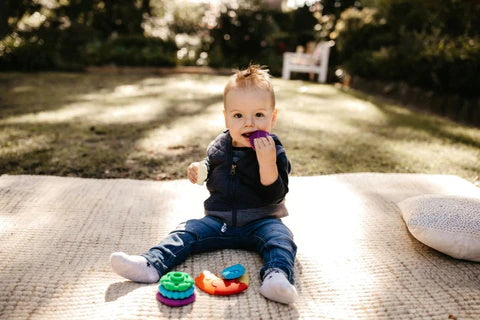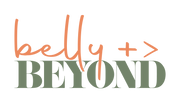Jellystone | 5 Fast Facts About Teething & Toys

For the busy mum and dad, we’ve put together Five Fast Facts about teething, toys and different development milestones that your bub is going to experience and why these are all important to consider.
Let’s get started!
How do I know when a baby is teething?
A baby’s first tooth is an exciting milestone and will generally occur at around 6–10 months, sometimes earlier or later. Babies can continue the teething process right up until their 3rd birthday when they have a complete set of teeth.
There are a number of signs parents can look out for to know when their baby is going through teething, these can include:
- Sore and red gums where the tooth is sprouting
- Flushed, red cheeks
- More dribbling than usual
- Increased irritability and fussy eating
- The desire to chew on fingers and other objects
Read more on this topic: Teething Signs and Symptoms

Why do babies often bring objects to their mouth?
Babies commonly bring objects to their mouth, and there’s a reason for this. A baby has more nerve endings in their mouth than any other part of their body, meaning this is how a baby will test to see how something feels or tastes. As a result, it’s important to make sure your child has access to objects like teething toys that are safe to explore as they go through this stage in their development.
Read more on this topic: Why Does My Baby Put Everything in Her Mouth?
How do babies develop spatial awareness?
Babies start to develop spatial awareness from a very young age; the first milestone for spatial relationships is when a baby can hold objects in their hands as they sense the position and movement of their own body. Teething toys that are easy to hold are great for helping babies grow their spatial awareness as they explore different actions and movements like holding, shaking and dropping.
Read more on this topic: The Mind-Body Connection! 6 Activities to Help Kids Build Spatial Awareness

How can I help my child develop their fine motor skills?
Fine motor skills refer to the movements we make with the small muscles of our hands. Babies begin to use their hands from birth in ways like bringing their hands to their mouth. As the child gets older, they will develop their fine motor skills and around 8–12 months they will start to do things like reach and grab objects, pinch small objects and hold their own bottle. Teething toys like our Rainbow Stacker and Colour Wheel (Bright & Pastel) are excellent for helping children develop their fine motor skills as the toy is easy for little hands to hold onto and allows them to explore different movements that work towards putting the pieces of the toy together.
The Penguin Wobble is also great for babies learning to crawl or as they are having tummy time. This silicone toy with weighted base will rock backwards and forwards and side to side, when pushed by little hands. When the Penguin Wobble is knocked, shaked, and toppled in all directions, it will always wobble back up again, ready for more fun!

Read more on this topic: Infant Developmental Milestones
Why are colours important for babies?
Colour can be used to aid the development of your child. Research shows that from birth to around 3 months, babies can primarily see in shades of black, white and grey. This means exposing babies to these colours will send the strongest signals to a baby’s brain, meaning faster visual development. So in the early months, toys and objects with strong visual contrast, such as black and white, will be very engaging for a baby. That is another reason why the Penguin Wobble is a great toy for little ones.
As the child gets older, introducing bright colours plays an important role in development, with babies having a preference of bright colours for brain stimulation.

Read more on this topic: The Importance of Colour During Your Child's Early Years
Blog post contributed by Jellystone Designs.
Read more articles contributed by Jellystone Designs on our blog:
- The Many Benefits of Sensory Toys and Tools for Babies & Children
- Open-Ended Play: What is it & Why is it Important?
- 5 Ways to Comfort a Teething Baby




